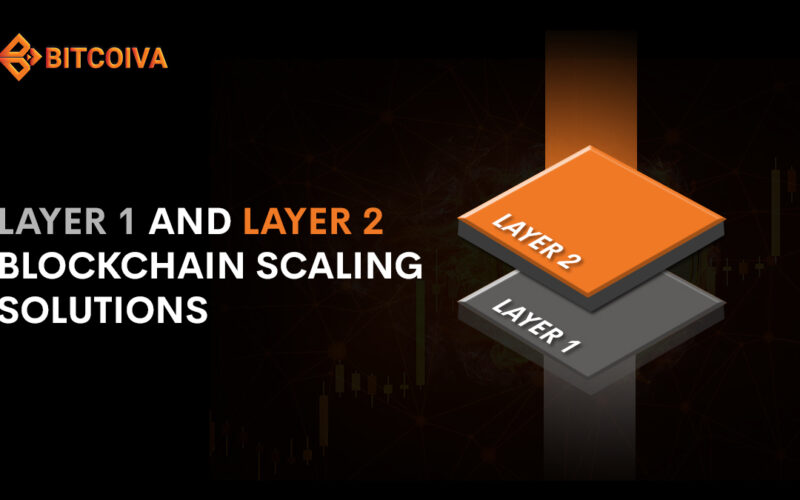What are the Blockchain Layers?
Blockchain technology is a stored mechanism for transferring data in a complex network. It is a distributed ledger that stores transaction records. For Example, Bitcoin runs on its blockchain network, where every transaction, such as buying and selling, is stored in the overall network. Notably, Bitcoin is not a single entity; it is owned by everyone who participated in the transactions.
The blockchain’s architecture has five layers: hardware infrastructure layer, data layer, network layer, consensus layer, and application layer. You can Buy the Layer 1 and Layer 2 tokens in Bitcoiva, the best cryptocurrency exchange in India.
Hardware Layer
The hardware infrastructure layer consists of peer-to-peer information sharing. It includes summating all nodes (computers or networks of computers involved in the blockchain), contributing to computing power, and decrypting techniques during transactions.
Data Layer
The data layer stores all the transactions executed on the blockchain, which contains the details of the crypto to be sent, the sender’s private key, and the receiver’s public key. Each block is connected to its previous and next block in the network. The first block always moves in the forward direction rather than in the backward position.
Network Layer
The network layer enables communication between the different nodes.
Consensus Layer
The consensus layer is responsible for validating a block. It receives transactions, validates them, and adds them to the blockchain.
For example, Peter receives transactions A and B, and Joseph receives transactions B and C. In this transaction, B occurs twice. To avoid these occurrences, Proof of work is implemented. Peter and Joseph compete with each other to solve a mathematical puzzle, and those who solve the mechanism at first will be added to the blockchain. In the Proofproof-of-stake mechanism, the system randomly picks the validator.
Application layer
The application layer can be anything, such as wallets, websites, or NFT Platforms, to make the integrations with users and transactions.
Blockchain Layers
The different layers of blockchain are as follows
Layer 0
It is the underlying blockchain infrastructure that facilitates communication from the top to different layers. Layer 0 contains the network’s hardware, protocols, and other functional elements. The layer 0 blockchain allows various networks to function, such as Bitcoin, Ethereum, etc.,
Layer 1
It is the advancement of layer 0 blockchain, and scaling is a limitation of layer one blockchain. If any changes or updations in Layer 1 will also affect the Layer 0 blockchain.
Layer 2
Layer 2 has better scaling capabilities and can also be integrated with third-party solutions. It is the most popular approach to solving the scaling issue, and many industries are beginning to implement POW networks.
Layer 3
It is the layer that hosts dApps and many other protocols for user interaction. It has two important sub-layers: application and execution. Layer 3 blockchain is also referred to as “application layers.” This layer targets real-time interoperability between separate blockchains with cross-chain capabilities.
What is Blockchain Scalability?
It is the ability to support the additional loads of transactions and nodes in a network. Scalability and security play a significant role in Blockchain networks.
Layer 1 Blockchain Scaling Solutions
Increased Block size
Some of the Layer 1 cryptocurrency blockchains have updated their code to verify more transactions at a time and increase the block size, thus expanding the network’s overall capacity. For example, the Bitcoin Cash (BCH) network underwent significant upgrades, increasing its block size from 1 MB to 8 MB and 32 MB. This enhancement enabled the BCH network to process over 100 transactions per second.
Consensus Mechanism
A blockchain mechanism validates network transactions to ensure accuracy and security. Bitcoin uses the Proof-Of-Work consensus mechanism, which requires more processing power to solve a complex equation to record the next block in the blockchain. The Ethereum blockchain initially utilized the PoW consensus mechanism and upgraded to the PoS mechanism to process large transactions.
Sharding
Sharding refers to partitioning the database into smaller parts, which increases the overall capacity and transaction process of the Layer1 Blockchain Network.
Layer 2 Blockchain Scaling Solutions
Rollups
To reduce the number of transactions, the rollup combines the bundle of transactions into single transactions and brings them into the main chain as a single entity.
Side Chains
Side Chains are independent blockchain networks that increase the transaction-processing power of a blockchain with their own set of validators. They allow transactions to be processed in parallel and connect to the main blockchain.
State Channels
It will record the transactions in bulk off-chain when the state of the off-chain is completed, and it will be recorded in bulk on-chain, which completes the state of the leading network.
Bitcoiva
The token name is BITCOIVA, and it is of type BEP20. The token sale ends at BCA. The token supply is 2,100,000.
BEP-20 is a Binance Smart Chain (BSC) token standard, a layer 1 blockchain protocol. Therefore, BEP-20 operates at the application layer of the blockchain protocol stack. It defines a set of rules for creating and managing tokens on the Binance Smart Chain, similar to Ethereum’s ERC-20 standard.
Visit: www.bitcoiva.com

